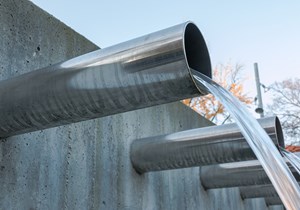Separation of stormwater boosts Glens Falls sewer system's performance
(UI) — Over the past few years, in the city of Glens Falls, New York, a $17 million project has been undertaken to separate a portion of its water from the main flow. Specifically, the project focuses on isolating stormwater from the Glens Falls sewer line.
This strategic decision has proven to be advantageous, resulting in significant benefits.
Data on why the separation is important were made public this week by the city. Bypassing (overflowing) less sewage through the Glens Falls Wastewater Treatment Plant and into the Hudson River has resulted in a reduction of up to 85%.
Mayor Bill Collins claims that there have been 50% fewer bypasses altogether. Any sewage that does enter the facility is mixed with purified water before being released into the Hudson River, where the city claims there is minimal influence on the water.
By separating the flows into separate sets of pipes, sewage is less likely to become entangled with rainwater flow and enter the Hudson River. On a day with clear sky, that is fine as is, but when it rains, it is quite different.
“Glens Falls and the surrounding area have experienced an increase of intense rain events over the last couple of years,” Water and Sewer Department Superintendent Bill Norton told InformNNY news. “When we receive a large amount of rain in a short period of time, the result is the collection system experiencing a rapid increase in flow, that peaks, and then quickly dissipates.”
When rain falls at a rate of more than 0.1 inches in a 15-minute period, sewage is most likely to skip the wastewater treatment plant, putting additional strain on the facility. The likelihood that anything from the sewage pipes will end up contacting the Hudson decreases as more rain is dispersed across a number of hours.
There has been a progressive decrease in sewage overflow, with fewer bypass occurrences seen during recent wet periods. Additionally, tributaries from Queensbury, Moreau, and South Glens Falls, which together account for roughly 32% of the sewage flow handled by the plant each day, also feed sewage into the Glens Falls wastewater treatment facility. The city also aims to maintain enhancing the flow of its water, particularly in light of upcoming construction on South, Broad, Elm, Warren, Glen, Bay, and Ridge Streets.
“Additional efforts to reduce the stormwater impact on the sanitary sewer line have been made by using bio-retention basins, rain gardens, and dry wells to collect the runoff and allow the water to seep into the ground after receiving any amount of rainfall,” said Collins told InformNNY news. “The City of Glens Falls has concentrated on separating the combined sewer systems while performing road construction and repair projects.”
Related News
From Archive

- Glenfarne Alaska LNG targets late-2026 construction start for 807-mile pipeline project
- U.S. water reuse boom to fuel $47 billion in infrastructure spending through 2035
- $2.3 billion approved to construct 236-mile Texas-to-Gulf gas pipeline
- Major water pipe break in Puerto Rico hits over 165,000 customers
- Potomac River Tunnel project enters construction phase beneath Washington, D.C.
- Pennsylvania American Water launches interactive map to identify, replace lead water service lines
- Trump's tariffs drive $33 million cost increase for Cincinnati sewer project
- Utah city launches historic $70 million tunnel project using box jacking under active rail line
- Tulsa residents warned after sewer lines damaged by boring work
- Fatal trench collapse halts sewer construction in Massachusetts; two workers hospitalized




Comments